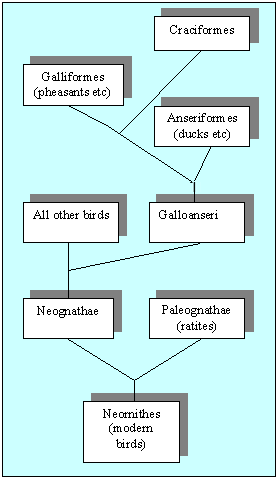Sibley-Ahlquist taxonomy
|
|
de:Sibley-Ahlquist Taxonomie fr:Sibley-Ahlquist taxonomie ja:Sibley-Ahlquist鳥類分類 nl:Sibley-Ahlquist taxonomie van de vogels zh:鳥類DNA分類系統 The Sibley-Ahlquist taxonomy is a radical new approach to bird taxonomy based on DNA studies which gives an arrangement differing greatly from the more traditional approach used in list of birds. The major changes at order level are as follows;
- Enlarged Struthioniformes replaces the ratite orders Rheiformes rheas, Casuariiformes cassowaries, and Apterygiformes kiwis and Struthioniformes ostriches
- Tinamiformes tinamous unchanged
- New greatly enlarged Ciconiiformes includes the previous Sphenisciformes penguins, Gaviiformes divers, Podicipediformes grebes, Procellariiformes tubenoses, Pelecaniformes pelicans and allies, Ciconiiformes storks and allies, Falconiformes birds of prey, Charadriiformes waders gulls terns and auks.
- Anseriformes ducks and allies unchanged
- New Craciformes chachalacas etc. Previously Galliformes
- New Gruiformes Cranes
- New Turniciformes button-quails etc. Previously Gruiformes
- Columbiformes doves unchanged
- New Musophagiformes turacos. Previously Cuculiformes.
- New Cuculiformes rest of cuckoos
- New Apodiformes swifts
- New Trochiliformes hummingbirds. Previously Apodiformes.
- Coliiformes mousebirds unchanged
- Trogoniformes trogons unchanged
- New Coraciiformes rollers
- New Upupiformes Hoopoe, previously Coraciiformes
- New Bucerotiformes hornbills, previously Coraciiformes
- New Galbuliformes jacamars, previously Piciformes
- Piciformes woodpeckers
- Passeriformes perching birds unchanged.
This revolutionary reordering has been widely accepted by North American ornithologists, including the American Ornithologists' Union, but in other parts of the world its adoption has been more deliberative: it has been a respected major influence on existing classification schemes, as opposed to a complete replacement for them.
A more recent paper looked at the ancestry of bird groups. The traditional view of avian evolution places ratites and tinamous at the base of the tree of modern birds (Neornithes), followed by old marine groups such as the penguins, grebes and divers (loons).
The new research suggested that the ducks and gallinaceous birds are each other's closest relatives and together form the basal lineage of neognathous birds. The ratites and tinamous will now be followed by the ducks and their allies, and then the pheasants and their allies.
This latter research has been accepted by the British Ornithologists' Union, and the British list will now start with Anseriformes and Galliformes.
See also:
- Charles Sibley
- The Sibley-Monroe checklist, multiple parts:
- part 1 - Struthionidae to Odontophoridae
- part 2 - Anhimidae to Picidae
- part 3 - Megalaimidae to Todidae
- part 4 - Alcedinidae to Psittacidae
- part 5 - Apodidae to Musophagidae
- part 6 - Tytonidae to Columbidae
- part 7 - Eurypigidae to Jacanidae
- part 8 - Chionididae to Falconidae
- part 9 - Podicipedidae to Hydrobatidae
- part 10 - Acanthisittidae to Tyrannidae
- part 11 - Thamnophilidae to Rhinocryptidae
- part 12 - Climacteridae to Vireonidae
- part 13 - Corvidae
- part 14 - Callaeidae to Sturnidae
- part 15 - Sittidae to Cisticolidae
- part 16 - Zosteropidae
- part 17 - Alaudidae to Passeridae
- part 18 - Fringillidae
See also
References
- Sibley, C. G., and J. Ahlquist. 1990. Phylogeny and classification of birds. Yale University Press, New Haven, Conn.
- The Early History of Modern Birds Inferred from DNA Sequences of Nuclear and Mitochondrial Ribosomal Genes (http://www.stanford.edu/group/hadlylab/images/Lab%20Members/Marcel/MBEOO.pdf), by Marcel van Tuinen, Charles G. Sibley, and S. Blair Hedges Department of Biology, Institute of Molecular Evolutionary Genetics, and Astrobiology Research Center, Pennsylvania State University

